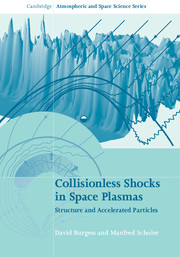Book contents
- Frontmatter
- Contents
- Preface
- Chapter 1 Shocks
- Chapter 2 Basic concepts
- Chapter 3 The quasi-perpendicular shock: macrostructure
- Chapter 4 The quasi-perpendicular shock: microstructure
- Chapter 5 The quasi-parallel shock
- Chapter 6 Diffusive shock acceleration
- Chapter 7 Coherent shock acceleration
- Chapter 8 Electron acceleration
- Chapter 9 Global and modified shocks
- Appendix Simulation techniques
- References
- Further reading
- Index
Chapter 4 - The quasi-perpendicular shock: microstructure
Published online by Cambridge University Press: 05 August 2015
- Frontmatter
- Contents
- Preface
- Chapter 1 Shocks
- Chapter 2 Basic concepts
- Chapter 3 The quasi-perpendicular shock: macrostructure
- Chapter 4 The quasi-perpendicular shock: microstructure
- Chapter 5 The quasi-parallel shock
- Chapter 6 Diffusive shock acceleration
- Chapter 7 Coherent shock acceleration
- Chapter 8 Electron acceleration
- Chapter 9 Global and modified shocks
- Appendix Simulation techniques
- References
- Further reading
- Index
Summary
Introduction
The accumulation of observations of the quasi-perpendicular, high Mach number terrestrial bow shock has led to a consensus view that the main features of shock heating can be explained by a time-stationary macroscopic model for the shock fields: specular reflection of some fraction of the ions produces the bulk of the heating required by the shock jump conditions, and the macroscopic profile of electric and magnetic field adjusts to provide the required reflected fraction; the electron heating is mediated by the cross-shock electric potential in the de Hoffmann–Teller frame. However, as discussed in Chapter 3, although the emphasis is on the macroscopic fields, small-scale fluctuations are vital for a convincing and self-consistent shock model, even on a conceptual basis. Wave–particle coupling in turbulent fluctuations is required to explain ion isotropization, the infilling of the electron distribution function, and, perhaps most importantly, time irreversibility and entropy increase at the shock, all of which a static macrostructure is incapable of providing.
In this chapter we discuss the various sources of microstructure at the quasi-perpendicular shock, concentrating on the high Mach number regime. Of course, there is a certain degree of arbitrariness in the distinction between macro-and microstructure. At one extreme one could assign the heating and dissipation at the shock entirely to the effects of inhomogeneous fluctuations, and then the macro-scopic structure would take whatever form was dictated by a particular choice of spatial and temporal averages. However, the usual approach is to assume that there exists a well-defined underlying macrostructure, which can be related to a multi-fluid model of reflected and transmitted ions, producing the canonical foot–ramp–overshoot structure in the magnetic field. Once the macroscopic structure has been removed, the ensemble of plasma and field fluctuations which remains can give rise to anomalous dissipation and particle heating, acceleration of particles, shock ramp broadening and temporal/spatial changes of the shock structure.
- Type
- Chapter
- Information
- Collisionless Shocks in Space PlasmasStructure and Accelerated Particles, pp. 114 - 163Publisher: Cambridge University PressPrint publication year: 2015



